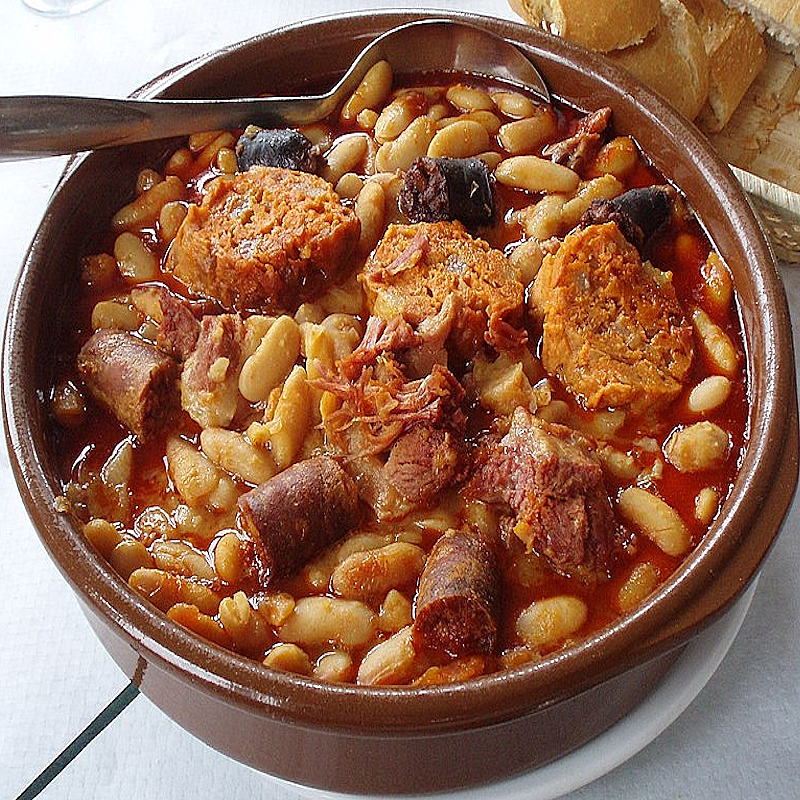Cassoulet Asturien - Fabada Asturiana
 Garanties sécurité
Garanties sécurité
(à modifier dans le module "Réassurance")
 Politique de livraison
Politique de livraison
(à modifier dans le module "Réassurance")
 Politique retours
Politique retours
(à modifier dans le module "Réassurance")
Cassoulet Asturien - Fabada Asturiana
Fabada Asturiana is one of the most iconic dishes in Spanish cuisine, originating from Asturias, a region located in the north of Spain, between the mountains and the Atlantic coast. This hearty and comforting stew is traditionally eaten in winter, especially during holidays and special occasions. It consists of fabes (Asturian white beans), chorizo, morcilla (black pudding), tocino (bacon), and other salted meats, which together create an explosion of flavors.
Origin and History
The Fabada Asturiana has its roots in the rural areas of Asturias, where the cultivation of white beans (fabes) is a centuries-old tradition. Although the first signs of its existence date back to the 17th century, this dish became truly popular in the 19th century. It is believed to have been created by the mountain dwellers to keep warm during the harsh winters. This protein- and calorie-rich dish was ideal for feeding farm and mine workers in the region.
Traditional Recipe
Fabada Asturiana is characterized by its slow cooking and the harmonious mix of simple but high-quality ingredients. Here’s a traditional version of the recipe:
Ingredients:
- 500 g of fabes (Asturian white beans)
- 1 chorizo (unsmoked)
- 1 morcilla (Asturian black pudding)
- 300 g of tocino rayado (larded bacon)
- 1 ham or ham bones
- 1 onion
- 2 garlic cloves
- 1 bay leaf
- Pimentón (Spanish paprika) or saffron threads
- Olive oil
- Salt and pepper
Preparation:
- Soak the beans in cold water the night before.
- Place all the ingredients in a large pot and cover with cold water so that the water is about a finger's width above the beans. Keep the onion and garlic whole.
- Bring to a boil, then remove the foam that forms on the surface. Add a bit of cold water to stop the cooking and prevent the beans from splitting. Repeat one or two times, then let it simmer on low heat for about 1.5 hours.
- Check occasionally and add cold water if needed. Do not stir the beans to avoid breaking them, just gently shake the pot to mix.
- Once the beans are tender, add salt if necessary (often the bacon is enough). Blend the onion, a few beans, some cooking liquid, paprika, and saffron, then add this mixture back into the pot. Let it cook for a few more minutes.
- Turn off the heat and let it rest for a few minutes to thicken the broth. Serve with a drizzle of olive oil (optional).
Tips:
- The beans should be cooked to your liking.
- Poke the chorizos and morcillas lightly at the start of cooking to prevent them from splitting.
- The quality of the beans is essential. Choose the "granja" variety, large and white.
- Don’t add salt too early, as it may cause the beans to break; the bacon often provides enough salt.
Recommended Beverages to Pair with Fabada Asturiana
Fabada Asturiana is a rich and flavorful dish that pairs perfectly with robust Spanish wines. Here are some suggestions:
- Red Wine: A Tempranillo or Mencía from Spain, with its fruity aromas and light to medium structure, pairs well with the salted meats and the spicy character of the chorizo and morcilla.
- White Wine: For those who prefer white wine, an Albariño from Galicia, fresh and crisp, with a slight acidity, can balance the richness and fattiness of the fabada.
- Asturian Cider: Another typically regional choice would be Asturian cider (sidra), slightly effervescent, bringing a refreshing and light touch to balance the richness of the dish.
History of Fabada
The origins of fabada date back to the 16th century when "fabes" (beans) were already cultivated and consumed in Asturias. The beans used for fabada are called "de la Granja," a sweet and creamy variety, ideal for this dish. This type of bean covers about 2,500 hectares in Asturias.
The exact origin of fabada is unclear. Some researchers suggest it originated in the 18th century, though no historical proof confirms this. While beans were typically a rural ingredient, some popular beliefs suggest that fabada might have originated in the cities. However, there is no mention of this dish in the literary works of the time, even in La Regenta, a work that describes the local customs in detail.
Some theories compare fabada to the French cassoulet, a dish that may have arrived in Spain via the Camino de Santiago. The first written mention of fabada appears in 1884 in the Asturian newspaper El Comercio, though no recipe is provided.
Over the years, fabada has become a staple dish in Asturian cuisine. It is mentioned in culinary literature from the early 20th century and was spread internationally by Asturian emigrants, especially in Tampa, USA, where variations of the dish exist.
In Colombia, an adapted version of fabada is known as bandeja paisa, where "fabes" are replaced with "bola roja" beans (soaked for 12 to 16 hours) and cooked with pig's feet, onions, garlic, chorizo, pork cracklings, cooked ground meat, a fried egg, avocado slices, and white rice.


